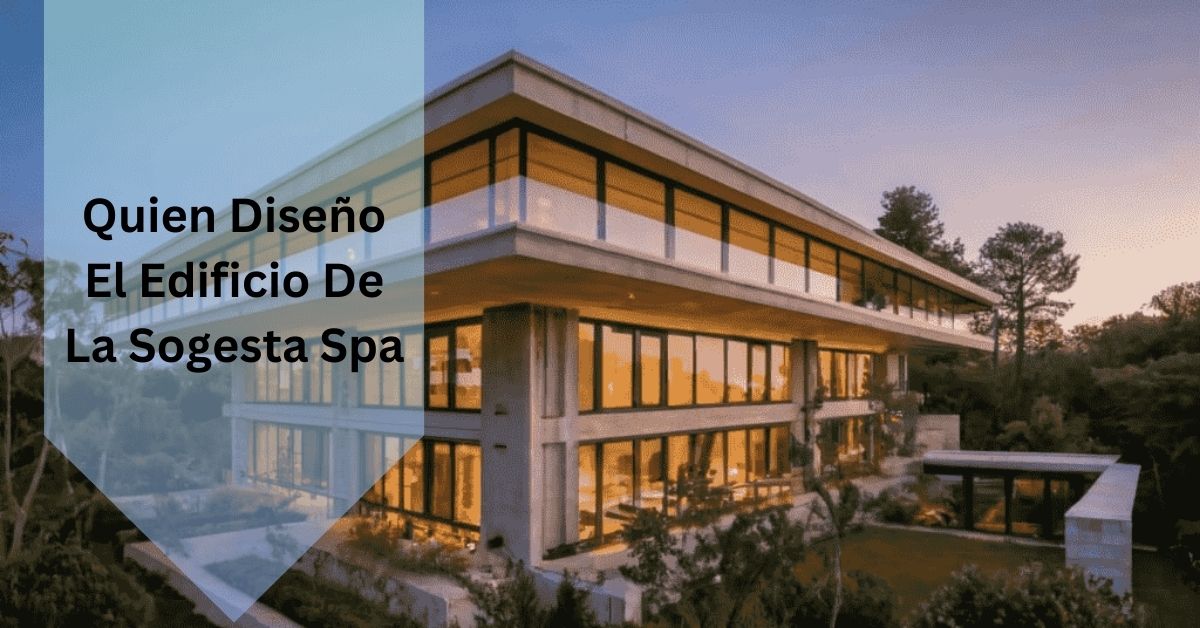Quien Diseño El Edificio De La Sogesta Spa – Exploring The Architectural Mastermind!
Introduction:
Architecture plays a vital role in shaping our experiences in spaces, be it for work, leisure, or wellness. One notable example is the Sogesta Spa building, an architectural masterpiece that merges form, function, and sustainability. But behind every iconic structure is an architect whose vision brings it to life. If you’re curious about who designed the Sogesta Spa building and what inspired its creation, you’re in the right place.
This article dives deep into the architect’s philosophy, the building’s design elements, and its impact on modern wellness architecture.
Overview of the Sogesta Spa Building:
Before we delve into the mind behind its creation, let’s first understand the Sogesta Spa building itself. Located in a picturesque setting, this spa is more than just a place for relaxation; it is a testament to innovative design. The building seamlessly integrates with its natural surroundings, offering a tranquil and immersive experience to visitors.
Purpose and Function
The primary goal of the Sogesta Spa building is to provide a sanctuary for wellness and relaxation. It was designed with the intention of harmonizing the body and mind through architecture, a space that promotes serenity while enhancing the spa’s services. The design prioritizes open spaces, natural light, and eco-friendly materials to cultivate an atmosphere of peace and balance.
Aesthetic Harmony
One of the standout features of the Sogesta Spa building is its ability to blend into its environment. Rather than overpowering the natural beauty surrounding it, the structure serves as an extension of the landscape. The use of materials like wood, glass, and stone adds to its aesthetic appeal while reinforcing the sense of calm and connection to nature.
The Architect Behind Sogesta Spa:
So, who designed the Sogesta Spa building? The architect behind this innovative design is someone deeply connected to sustainable architecture and wellness spaces. While the name may not be as widely recognized in mainstream media, the influence of their work is evident in architectural circles focused on green, eco-friendly design.
Visionary Approach to Design
The architect’s design philosophy revolves around a holistic approach to wellness. They believe that architecture is not just about creating a functional space but an experience that enhances well-being. This is evident in the Sogesta Spa building, where every element, from the layout to the choice of materials, contributes to a calming atmosphere that aligns with the spa’s core mission.
A Champion of Sustainability
Sustainability is at the heart of the Sogesta Spa’s design. The architect’s commitment to eco-friendly design is reflected in the building’s construction. By using natural materials, energy-efficient systems, and sustainable building practices, they ensured that the structure would have a minimal environmental footprint. This focus on sustainability not only benefits the environment but also enhances the wellness experience for visitors, creating a space that feels in tune with nature.
Also Read: Fundz Olankz – A New Era in Financial Platforms!
Design Elements of the Sogesta Spa Building:
Integration with the Natural Landscape
One of the key aspects of the Sogesta Spa building’s design is its integration with the surrounding landscape. The architect ensured that the building blends harmoniously with its natural environment. Large windows and open spaces allow guests to feel connected to the outdoors while still enjoying the comfort of indoor spa facilities.
Open and Airy Spaces
The use of open spaces and natural light is a defining feature of the Sogesta Spa design. The architect strategically incorporated skylights, large windows, and open layouts to create a sense of openness and tranquility. These design choices also reduce the need for artificial lighting, making the building more energy-efficient.
Minimalist Aesthetic
The Sogesta Spa building follows a minimalist design approach, focusing on clean lines and simple geometric shapes. This minimalist aesthetic allows the natural materials and surroundings to take center stage, creating a soothing atmosphere. The lack of clutter and unnecessary ornamentation ensures that visitors can focus on relaxation and mindfulness.
Sustainable Materials
From the wooden beams to the stone facades, the materials used in the construction of the Sogesta Spa building were chosen for their sustainability. Not only are these materials eco-friendly, but they also contribute to the building’s natural, earthy feel. The use of locally sourced materials further minimizes the environmental impact of the building’s construction.
The Role of Architecture in Wellness:
The Sogesta Spa building is more than just a structure; it’s an integral part of the wellness experience offered by the spa. The design contributes to the emotional and physical well-being of its visitors, providing an environment that fosters relaxation, rejuvenation, and healing.
Enhancing Wellness Through Design
The architect behind the Sogesta Spa building understands the power of design in influencing wellness. By incorporating natural elements, open spaces, and eco-friendly materials, the building serves as a space where visitors can truly disconnect from the stresses of daily life and reconnect with themselves.
The Impact of Nature on Well-Being
Numerous studies have shown that exposure to nature can have a positive impact on mental health and well-being. The architect’s decision to integrate the Sogesta Spa building with its natural surroundings allows visitors to experience the therapeutic effects of nature, even when indoors. The large windows and open spaces bring the outside in, creating a seamless connection between the natural world and the built environment.
Architectural Trends Reflected in the Sogesta Spa Design:
The design of the Sogesta Spa building reflects several key trends in modern architecture, particularly in the wellness and hospitality industries.
Sustainable Architecture
Sustainable architecture is no longer a niche trend; it’s becoming the standard in modern building design. The Sogesta Spa building exemplifies this shift towards sustainability with its use of eco-friendly materials, energy-efficient systems, and environmentally conscious construction practices.
Minimalism and Wellness
Minimalism has long been associated with mental clarity and well-being. By focusing on clean lines, open spaces, and a neutral color palette, the architect behind the Sogesta Spa building has created a space that promotes relaxation and mindfulness.
Biophilic Design
Biophilic design, which focuses on connecting people with nature, is another trend reflected in the Sogesta Spa building. By incorporating natural materials, abundant natural light, and views of the surrounding landscape, the architect has created a space that nurtures both the body and mind.
Also Read: Wife Crazy Stacie – Know Everything About Her!
The Legacy of the Sogesta Spa Architect:
The architect behind the Sogesta Spa building has left a lasting legacy in the world of wellness architecture. Their commitment to sustainability, minimalist design, and the integration of nature has set a new standard for spa and wellness facilities around the world.
Influence on Future Architectural Projects
The success of the Sogesta Spa building is likely to influence future architectural projects, particularly in the wellness and hospitality industries. Architects and developers are increasingly recognizing the importance of sustainable, biophilic design in creating spaces that enhance well-being.
A Model for Wellness Architecture
The Sogesta Spa building serves as a model for future wellness architecture, demonstrating how thoughtful design can contribute to a holistic wellness experience. By prioritizing sustainability, natural elements, and open spaces, the architect has created a space that nurtures the mind, body, and spirit.
FAQ’s:
1. Who designed the Sogesta Spa building?
The Sogesta Spa building was designed by an architect specializing in sustainable and wellness-focused architecture, though the specific name may not be widely recognized.
2. What architectural style does the Sogesta Spa building follow?
The building follows a minimalist, biophilic design style, characterized by clean lines, natural materials, and an emphasis on sustainability.
3. How does the Sogesta Spa building integrate with nature?
The building features large windows, open spaces, and natural materials like wood and stone, allowing it to blend seamlessly with the surrounding landscape.
4. What materials were used in the construction of the Sogesta Spa building?
The architect used eco-friendly and locally sourced materials, including wood, stone, and glass, to ensure sustainability and a natural aesthetic.
5. Is the Sogesta Spa building eco-friendly?
Yes, the building was designed with sustainability in mind, featuring energy-efficient systems, natural lighting, and eco-friendly materials.
6. What makes the Sogesta Spa building unique?
Its minimalist design, use of natural materials, and focus on integrating with the natural environment make the Sogesta Spa building a standout example of wellness architecture.
7. How does the design of the Sogesta Spa building enhance the wellness experience?
The open spaces, natural light, and calming atmosphere created by the design promote relaxation and mental clarity, enhancing the overall wellness experience for visitors.
8. What is biophilic design, and how is it reflected in the Sogesta Spa building?
Biophilic design is an architectural approach that seeks to connect people with nature. The Sogesta Spa building incorporates natural materials, light, and views of the landscape to achieve this connection.
9. How does sustainability play a role in the design of the Sogesta Spa building?
Sustainability is a key aspect of the design, with the architect using eco-friendly materials, energy-efficient systems, and sustainable construction practices.
Conclusion:
The Sogesta Spa building is more than just a functional structure; it’s a work of art that embodies the principles of modern, sustainable architecture. The architect behind this design has created a space that not only serves its purpose but also enhances the wellness experience for its visitors. Through the use of natural materials, open spaces, and eco-friendly design, the Sogesta Spa building has set a new standard for wellness facilities around the world.
Read More:














Post Comment